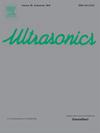一个镜头,一个SoS:一个实时的,单镜头的全球声音速度估计器
IF 3.8
2区 物理与天体物理
Q1 ACOUSTICS
引用次数: 0
摘要
声速(SoS),即声波在介质中的传播速度,是人体组织的固有特性,已成为健康诊断中一种新的生物标记。遗憾的是,目前还没有任何技术能切实证明组织的 SoS 可以通过成像换能器的单脉冲回波传输进行稳健测量,因此将 SoS 估算纳入超声成像管道在技术上仍具有挑战性。在本文中,我们提出了一种新颖的全局 SoS 估算算法,该算法只需一次转向平面波传输即可运行。我们的单发框架通过以下方法得出 SoS 估计值:1)计算每个像素的预波束形成的归一化自相关系数总和(SNAC),该总和来自假定 SoS 的延时信道数据集;2)构建一个损失度量,该度量的定义是,对于不同的 SoS 候选者,不同像素的总 SNAC 的负值;3)找到损失值最小的 SoS。我们的单次 SoS 估算器是在便携式超声研究扫描仪上实时实现的(处理时间为 50 毫秒)。体外测试使用琼脂阶梯模型(SoS 范围:1508-1682 m/s),体内测试使用瘦小的人类小牛(SoS 范围:1573-1589 m/s)。所有的 SoS 估计值都通过参考传输测量值进行了验证。结果表明,我们的框架能准确估算 SoS,体外(0.4 ± 6.5 m/s)和体内(3.8 ± 15.7 m/s)的平均符号差(MSD)较小。当该框架扩展到 10 角多传输序列时,其 SoS 估计性能进一步提高,MSD 更小(0.2 ± 2.0 m/s)。所提出的单次 SoS 估计器的出现有助于推动 SoS 在组织表征中的新兴应用,并改善受 SoS 影响的其他成像过程,如波束成形和多普勒估计。本文章由计算机程序翻译,如有差异,请以英文原文为准。
One shot, one SoS: A real-time, single-shot global speed of sound estimator
Speed of sound (SoS), or the propagation speed of acoustic waves through a medium, is an intrinsic property of human tissue and has emerged as a new biomarker in health diagnostics. Alas, no existing technique has practically demonstrated that the tissue SoS can be robustly measured from a single pulse-echo transmission with an imaging transducer, so incorporating SoS estimation into the ultrasound imaging pipeline remains technically challenging. In this paper, we propose a novel global SoS estimation algorithm that requires only a single steered plane wave transmission for operation. Our single-shot framework derives the SoS estimate by 1) calculating each pixel’s pre-beamformed sum of normalized autocorrelation coefficients (SNAC) derived from the time-delayed channel data ensemble for an assumed SoS; 2) constructing a loss metric that is defined as, for different SoS candidates, the negated total SNAC over different pixels; 3) finding the SoS with the minimum loss value. Our single-shot SoS estimator was implemented in real-time (50 ms processing time) on a portable ultrasound research scanner. It was tested in vitro using agar staircase phantoms (SoS range: 1508–1682 m/s) and in vivo using svelte human calves (SoS range: 1573–1589 m/s). All SoS estimates were validated with reference through-transmission measurements. Results show that our framework yielded accurate SoS estimates with a small mean signed difference (MSD) in vitro (0.4 ± 6.5 m/s) and in vivo (3.8 ± 15.7 m/s). When the framework was extended to a 10-angle multi-transmission sequence, its SoS estimation performance was further improved with a smaller MSD (0.2 ± 2.0 m/s). The advent of the proposed single-shot SoS estimator can help advance the emerging use of SoS in tissue characterization and improve other imaging processes that are influenced by SoS, such as beamforming and Doppler estimation.
求助全文
通过发布文献求助,成功后即可免费获取论文全文。
去求助
来源期刊

Ultrasonics
医学-核医学
CiteScore
7.60
自引率
19.00%
发文量
186
审稿时长
3.9 months
期刊介绍:
Ultrasonics is the only internationally established journal which covers the entire field of ultrasound research and technology and all its many applications. Ultrasonics contains a variety of sections to keep readers fully informed and up-to-date on the whole spectrum of research and development throughout the world. Ultrasonics publishes papers of exceptional quality and of relevance to both academia and industry. Manuscripts in which ultrasonics is a central issue and not simply an incidental tool or minor issue, are welcomed.
As well as top quality original research papers and review articles by world renowned experts, Ultrasonics also regularly features short communications, a calendar of forthcoming events and special issues dedicated to topical subjects.
 求助内容:
求助内容: 应助结果提醒方式:
应助结果提醒方式:


